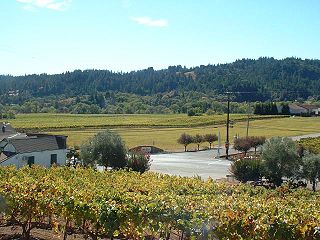
The Yadkin Valley AVA is an American Viticultural Area that includes land in eight counties of northwestern North Carolina. The AVA encompasses an area of approximately 1,400,000 acres (5,666 km2) in the Yadkin River valley. The Yadkin Valley AVA includes all of Wilkes, Surry, and Yadkin counties, and parts of Davie, Davidson, Forsyth, Iredell, and Stokes counties. Yadkin Valley is home to 48 wineries.

The Willamette Valley AVA, is an American Viticultural Area which lies in the Willamette Valley of Oregon. The AVA is the wine growing region which encompasses the drainage basin of the Willamette River. It stretches from the Columbia River in the north to just south of Eugene in the south, where the Willamette Valley ends; and from the Oregon Coast Range in the west to the Cascade Mountains in the east. At 5,360 square miles (13,900 km2), it is the largest AVA in the state, and contains most of the state's wineries; approximately 200 as of 2006.

Texas has a long history of wine production. The sunny and dry climate of the major winemaking regions in the state have drawn comparison to Portuguese wines, in addition to other regions in Europe like Spain, France, and Italy. Some of the earliest recorded Texas wines were produced by Spanish missionaries in the 1650s near El Paso. Texas ranked as the fifth largest wine producing state by 2019.

The Temecula Valley AVA is an American Viticultural Area in the Temecula Valley, located in southwestern Riverside County, California.
The North Fork of Roanoke AVA is an American Viticultural Area located on the eastern slopes of the Allegheny Mountains in the Roanoke and Montgomery counties of Virginia. About 22 miles (35 km) long and including parts of the Roanoke Valley, the AVA altitudes range from between 1,200 feet (366 m) and 2,200 feet (671 m) above sea level.
The Virginia's Eastern Shore AVA is an American Viticultural Area that includes a 70 miles (113 km) length of Virginia's Eastern Shore and consists of the counties of Accomack and Northampton. The topography in this AVA is mostly level and ranges from sea level to 50 feet (15 m) above sea level. The area is located on the southern end of the Delmarva Peninsula. The weather in the area is characterized by temperate summers and winters, significantly affected by the Chesapeake Bay and the Atlantic Ocean. The soil is sandy and deep.

Sonoma County wine is wine made in Sonoma County, California, in the United States.
The Mendocino Ridge AVA is a coastal, cool climate and high altitude American Viticultural Area located entirely within the coastal zone of Mendocino County, California. The boundaries of the AVA encompass the coastal ridges adjacent to the Pacific Ocean that reach inland toward the Anderson Valley. Roughly 36 miles of the southernmost portion of the Mendocino Coast make up the western boundary of the AVA, with the Sonoma County line as the southern boundary, the Navarro River as the northern boundary and Anderson Valley as the inland boundary running northwest–southeast. The Mendocino Ridge AVA "is essentially a northern extension of the true Sonoma Coast viticultural area." However, the Mendocino Ridge AVA designation is unique in that it is limited by elevation, reserved only for vineyards at or above 1200 feet. This is why the Mendocino Ridge AVA has been nicknamed "Islands in the Sky®," because the vineyards sitting at 1200 feet or higher are often perched above thick fog moving inland from the Pacific Ocean blanketing the coast and the valleys between the ridge tops, making the tips of the mountains look like islands protruding from a sea of fog. In this overlapping, "[t]he Mendocino Ridge AVA floats above the Anderson Valley and Mendocino appellations." Mendocino Ridge is the only non-contiguous AVA in the United States; all others are contiguous landmasses with all vineyards inside the boundaries designated as part of the AVA, whereas Mendocino Ridge in comparison only includes the higher altitude growing sites. "There are 262,400 acres within the outer boundaries of the Mendocino Ridge viticultural area, but the actual viticultural area encompasses only 87,466 acres which lie above 1,200 feet elevation. Of these 87,466 acres, approximately 1,500 to 2,000 acres of the ridge tops are suitable for vineyards. The side-slopes are very steep and covered with timber, making them unfit for planting". Estimates of planted acres range from 233 to 410, which accounts for about 0.3% of the total area. These planted acres are scattered among 16 remote vineyards.

The Texas Hill Country AVA is an American Viticultural Area located in the Texas Hill Country north of San Antonio and west of Austin, Texas. The appellation is the third largest American Viticultural Area in geographic area behind the Upper Mississippi River Valley AVA and Ohio River Valley AVA, covering an area of over 9,000,000 acres (14,062 sq mi). Established in 1991, it is the southernmost AVA. Today, there are around 80 wineries/vineyards. Despite the cultural influence of the local Texas German population, most of the grape varietals grown in the Texas Hill Country originate from France, Italy, or Spain rather than the cooler climate of Germany.
The Texas Davis Mountains AVA is an American Viticultural Area located in the Trans-Pecos region of West Texas. Surrounded by the Chihuahuan Desert, the appellation takes advantage of cooler elevation and lower annual rainfall in the Davis Mountains. The land within the boundaries of the AVA ranges between 4,500 feet (1,372 m) and 8,300 feet (2,530 m) above sea level. The soil is primarily granitic, porphyritic, and volcanic in nature. The hardiness zones are 7b and 8a.

The Grand Valley AVA is an American Viticultural Area located in Mesa County, Colorado, primarily in Grand Junction and Palisade. It is located roughly 200 miles West-Southwest of Denver. The high-desert AVA - with an average elevation of between 4,000 and 5,000 feet above sea level - is defined by the irrigated agricultural area served via canals within the Grand Valley of the Colorado River. The AVA was established in 1991 as the first of two Colorado wine regions. The West Elks AVA is the second federally designated AVA in Colorado.

The Shenandoah Valley AVA is an American Viticultural Area located in the Shenandoah Valley of Virginia and West Virginia. The valley is bounded by the Blue Ridge Mountains to the east and the Appalachian and Allegheny Plateaus to the west. Most of the AVA is in Virginia, with a small portion in the Eastern Panhandle of West Virginia. Most of the vineyards in the AVA are located in Virginia and grow a wide variety of Vitis vinifera, Vitis labrusca, and French hybrid grapes. The hardiness zone is mainly 6b except for some 7a closer to the mouth of the Shenandoah.

The Hermann AVA is an American Viticultural Area located in Gasconade County, Missouri, and entirely contained within the larger Ozark Mountain AVA. The wine appellation is located on the southern side of the Missouri River near the town of Hermann, about halfway between St. Louis and Jefferson City. The AVA covers the northernmost hills of the Ozark Plateau with many of the 200 acres of vineyards planted along hillside locations. As of 2007, seven wineries were producing wine in appellation, including Missouri's largest winery, Stone Hill Winery.

The Old Mission Peninsula AVA is an American Viticultural Area located in Grand Traverse County, Michigan known for well-regarded Michigan wine. The Old Mission Peninsula extends northward from Traverse City into the Grand Traverse Bay of Lake Michigan, ending at Old Mission Point. The peninsula is 19 miles (31 km) long by 3 miles (5 km) wide at its widest point. The climate on the peninsula is moderated by the surrounding waters, helping to prevent frost during the growing season. Grape varietals suitable to cool climates, such as Riesling, Chardonnay, Gewürztraminer, Pinot gris, Pinot noir, Cabernet Franc, and Merlot do best in the Old Mission Peninsula AVA.
The Outer Coastal Plain AVA is an American Viticultural Area located in southeastern New Jersey. The recently expanded 2,250,000 acres (911,000 ha) wine appellation includes all of Cumberland, Cape May, Atlantic, and Ocean counties and portions of Salem, Gloucester, Camden, Burlington, and Monmouth counties. The region is characterized by well-drained sandy or sandy loam soils of low to moderate fertility, and a relatively long growing season. The climate is moderated by the influence of the Atlantic Ocean and Delaware Bay. The region is in hardiness zones 6b, 7a, and 7b. The AVA contains one sub-region, the Cape May Peninsula AVA, which was established in 2018.
The Warren Hills AVA is an American Viticultural Area located in Warren County, New Jersey. The Warren Hills region includes several small valleys formed by tributaries of the Delaware River. The valleys drain from northeast to southwest, and most vineyards in the area are planted on southeast-facing hill slopes. The region is primarily planted with French hybrid grapes. It has a humid continental climate (Dfa/Dfb) and is located in hardiness zones 6b and 6a.

The Hudson River Region AVA is an American Viticultural Area around the Hudson River in eastern New York. The region is home to the oldest continuously operating winery in North America, the Brotherhood Winery, established in 1839. The oldest continuously cultivated vineyard in North America is also located in the Hudson River Region AVA, and is today operated by Benmarl Winery.

The Long Island AVA is an American Viticultural Area encompassing Nassau and Suffolk counties of New York, including the smaller offshore islands in those counties. The AVA was established in 2001, over 15 years after two smaller AVAs were created at the eastern end of Long Island. The Long Island AVA designation was promoted as a benefit for some wineries located just outside the two smaller AVAs and for wineries that wanted to create wines that use blends from vineyards in different parts of the island. It was also developed and promoted as a consumer protection of the Long Island name; AVAs require that a minimum of 85% of the fruit used in the designated wine is grown within the borders of the region. The "Long Island" AVA was authored by veteran Long Island winemaker Richard Olsen-Harbich who also authored "The Hamptons, Long Island" and "North Fork of Long Island" AVAs in the mid-1980s.
The Cape May Peninsula AVA is an American Viticultural Area located in extreme southern New Jersey. The 126,635 acres (51,000 ha) wine appellation includes most of Cape May county and a small portion of Cumberland county. The region is characterized by well-drained sandy or sandy loam soils of low to moderate fertility, and a relatively long growing season. The climate is strongly moderated by the influence of the Atlantic Ocean and Delaware Bay. The region is in hardiness zones 6b, 7a, and 7b. The AVA is entirely contained within the larger Outer Coastal Plain AVA, but is distinguished from it primarily by a more moderate temperature, providing for a longer growing season.
The Eastern Connecticut Highlands AVA is a American Viticultural Area established on October 11, 2019, covering the eastern highlands area in Connecticut. It is located in Hartford, New Haven, Tolland, Windham, New London, and Middlesex Counties. The area is primarily hilly, with elevations ranging from 200 to 1,000 feet. The eastern and western edges of the AVA have sharp ridgelines and higher elevations than the central portion of the AVA which has rounded hills.. The region is relatively cool, with a short growing season between mid-May and mid-September. Its climate is similar to the Finger Lakes region of New York, The soil in the area is composed of glacial till. Local vintners have had the most success with cool climate Vitis vinifera and French hybrid grape varieties. The region is located in hardiness zones 6a to 7a. Sharpe Hill Vineyard is both the oldest and the largest winery in the AVA. Steven Vollweiler, owner of Sharpe Hill Vineyard in Pomfret, CT, petitioned the TTB for the establishment of the new AVA.











